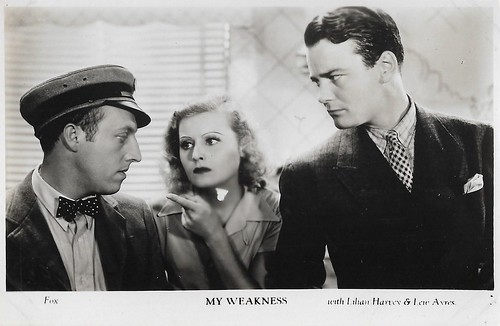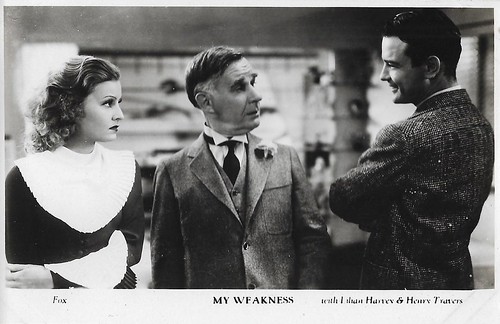
British postcard in the Picturegoer Series, London, no. 1339. Photo: Metro-Goldwyn-Mayer.

German postcard by Ross Verlag, no. 5347/1, 1930-1931. Photo: Metro-Goldwyn- Mayer. Greta Garbo and Lew Ayres in The Kiss (Jacques Feyder, 1929). Collection: Geoffrey Donaldson Institute.

Dutch postcard by Croeze-Bosman-Universal, no. 66. Lew Ayres and Louis Wolheim in All Quiet on the Western Front (Lewis Milestone, 1930), based on the novel 'Im Westen nichts Neues by Erich Maria Remarque.

British postcard in the Picturegoer Series, London, no. P 301. Photo: Metro-Goldwyn-Mayer. Lew Ayres and Laraine Day in The Secret of Dr. Kildare (Harold S. Bucquet, 1939).
Failing to make the leap to top Hollywood stardom
Lewis 'Lew' Frederick Ayres III was born in 1908 in Minneapolis, Minnesota to Irma and Louis Ayres. His parents were musicians and they divorced when he was four years old. He was therefore brought up for several years by his grandmother Anna, a piano teacher. As a child, he wanted to be a doctor, but his grandmother discovered his musical talent. He played the banjo and saxophone as well as the guitar.
In 1923 he moved with his mother, step-father William Gilmore and half-brother and half-sister to San Diego, where he also attended high school. He interrupted high school for a short time to work as a musician. Later, after graduating, he studied medicine at the University of Arizona in 1926. He played banjo and guitar in the university's jazz band along the way.
Lew dropped out of medical school and went on to play in jazz bands in Californian nightclubs. He recorded one of the earliest Vitaphone movie shorts called Carnival Night in Paris (?, 1927). In the Coconut Grove nightclub in Los Angeles, Ayres was discovered by Hollywood agent Ivan Kahn dancing with actress Lili Damita.
After two minor roles, he first generated attention with his third film, the silent drama The Kiss (Jacques Feyder, 1929). He played a naive youth who gives Greta Garbo's character a kiss, causing complications. His fourth film, the anti-war film All Quiet on the Western Front (Lewis Milestone, 1930) made him world famous. He played the leading role of the German soldier Paul Bäumer. The film adaptation of Erich Maria Remarque's novel 'Im Westen nichts Neues' won the Oscar for best film of the year.
In Germany, the film met with bitter protest from right-wing associations and National Socialists, mainly because of its pacifist stance in the German Reich. Joseph Goebbels called for a boycott of the film and other films by the makers. Ayres, however, received much praise from the US press for his performance. In the following years, however, the boyish-looking actor failed to make the leap to top Hollywood stardom.

German postcard by Ross Verlag, no. 4828/1, 1929-1930. Photo: DPC.

British postcard in the Picturegoer Series, London, no. 523. Greta Garbo and Lew Ayres in The Kiss (Jacques Feyder, 1929).

German postcard by Ross Verlag, no. 5347/1, 1930-1931. Photo: Metro Goldwyn Mayer. Greta Garbo and Lew Ayres in The Kiss (Jacques Feyder, 1929).

German postcard by Ross Verlag, no. 5516/1, 1930-1931. Photo: Metro Goldwyn Mayer. Greta Garbo and Lew Ayres in The Kiss (Jacques Feyder, 1929).
A good-natured, helpful and caring doctor
In the 1930s, Lew Ayres was confined to naive, somewhat spoiled young men from good homes in the vast majority of his roles. His more significant roles included an aspiring gangster in the crime film The Doorway to Hell (Archie Mayo, 1930) alongside James Cagney and a prizefighter in Iron Man (Tod Browning, 1931) who is abandoned by his lover, played by Jean Harlow.
In 1938 he again attracted attention when he played a tragicomic role in the screwball comedy Holiday (George Cukor, 1938). He played Katharine Hepburn's brother who suffers from his domineering father and drowns this in alcohol.
In the same year, Ayres got the role of Dr. Kildare in the B-movie Young Dr. Kildare (Harold S. Bucquet, 1938) at MGM. The film was such a success that Ayres portrayed the good-natured and helpful doctor in eight sequels until 1942. He also voiced Dr Kildare in a popular radio series in the 1940s.
During the Second World War, Ayres refused to go to war for the USA because he had become a pacifist, especially through his work on All Quiet on the Western Front. Public criticism arose of "the country's most famous conscientious objector" and MGM even released him from his contract because of it. His reputation was only restored when the public learned that he had worked as a medic for the US Army Medical Corps in New Guinea and the Philippines. Among other things, he was present at the evacuation in the Battle of Leyte.
After the war, Ayres resumed his film career, including a starring role alongside Olivia de Havilland in Robert Siodmak's thriller The Black Mirror (1946). In 1948, Ayres scored personal success alongside Jane Wyman in the drama Johnny Belinda (Jean Negulesco, 1948). The role of a sympathetic, caring doctor who looks after a deaf-mute woman earned him his only Oscar nomination in the Best Actor in a Leading Role category.

Dutch postcard by Croeze-Bosman-Universal, no. 65. Lew Ayres, Louis Wolheim and Owen Davis jr. in All Quiet on the Western Front (Lewis Milestone, 1930), based on the novel 'Im Westen nichts Neues by Erich Maria Remarque.

British postcard by Film Weekly. Photo: Fox. Lilian Harvey, Lew Ayres and Sid Silvers in My Weakness (David Butler, 1933).

British postcard by Film Weekly. Photo: Fox. Lilian Harvey and Lew Ayres in the musical romance My Weakness (David Butler, 1933). The other woman could be Susan Fleming, Irene Bentley, or Irene Ware.

British postcard by Film Weekly. Photo: Fox. Lilian Harvey, Henry Travers and Lew Ayres in My Weakness (David Butler, 1933).
Buried next to Frank Zappa
In the 1950s, Lew Ayres took on mostly guest roles on television but offers for him dwindled overall. His career took off again in the 1970s and 1980s. He took supporting roles in films such as the Science-Fiction film Battle for the Planet of the Apes (J. Lee Thompson, 1973), the Horror film Damien – Omen II (Don Taylor, 1978) with William Holden, and the Italian remake Don Camillo (Terence Hill, 1983) with Terence Hill as small-town priest Don Camillo.
The now greying Ayres played mostly understanding and friendly authority figures such as presidents, doctors and professors. He also appeared on television in series such as Little House on the Prairie (1982), Fame (1984) and The A-Team (1986). In the Columbo episode Devilish Intelligence (1974), he played a scientist of integrity who is murdered when he tries to uncover a scandal.
For a guest role opposite David Carradine in an episode of the TV series Kung Fu, The Vanishing Image (Barry Crane, 1974), he was nominated for an Emmy. In 1994, Ayres retired from the screen for good after over 150 film and television appearances with his appearance in the television film Hart to Hart: Secrets of the Hart (Peter Roger Hunt, 1994) starring Robert Wagner and Stefanie Powers.
Ayres directed the historical war drama Hearts in Bondage (Lew Ayres, 1936), starring Mae Clarke and David Manners, for Republic. Hearts in Bondage is notable as a rare example of a Hollywood film to depict the naval battles of the American Civil War. It remained his only directorial effort on a feature film. He later made two more documentaries: Altars of the East (1955) and Altars of the World (1976), both of which were devoted to the theme of religion. Altars of the World, his 150-minute documentary on the different religions of the world, won critical acclaim and the 1977 Golden Globe in the Best Documentary category.
Lew Ayres was married three times: first to actress Lola Lane between 1931 and 1933 and to Ginger Rogers from 1934 to 1940. In the late 1940s, he began a relationship with actress Jane Wyman, who left her then-husband Ronald Reagan for him. Wyman and Ayres broke up again after only a short time. He had one son, Justin Ayres, by his last marriage to Diana Hall, which lasted from 1964 until his death. The actor was very interested in philosophy and religion, lectured on these subjects and wrote numerous essays. He received an honorary doctorate from Oakland University in 1979 for his philosophical activities. Lew Ayres passed away in Los Angeles in 1996, two days after his 88th birthday. He died in his sleep after being in a coma for several days. Lew Ayres was buried in Westwood Village Memorial Park Cemetery in Westwood next to Frank Zappa.

British postcard in the Picturegoer Series, London, no. 454.

British postcard in the Picturegoer Series, London, no. 454a.

British postcard in the Picturegoer Series, no. W.575. Photo: Warner.

British postcard in the Picturegoer Series, London, no. 870. Photo: Fox.

German postcard by Ross Verlag, no. A 1397/1, 1937-1938. Photo: Paramount.
Sources: Bruce Cameron (IMDb), Wikipedia (German and English), and IMDb.
No comments:
Post a Comment